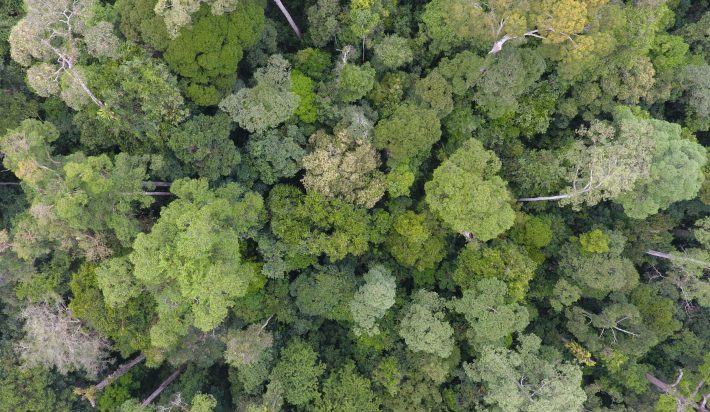Lianas more likely to infest smaller trees in Southeast Asian forests
University of Nottingham press release.
New research finds that lianas in Malaysian forests are more likely to infest smaller trees, transforming our knowledge of an understudied area. The findings are published in Journal of Ecology.

Woody climbing plants, known as lianas, are more likely to infest smaller trees in Malaysian forests and therefore stop them growing to their full potential, which may have implications for climate change.
This is according to new research by experts at the University of Nottingham carried out in Danum Valley in Malaysia, published today in Journal of Ecology.
The study’s findings contrast with previous liana studies in Neotropical forests (Central America, the Caribbean, and South America), which alters our understanding of tropical forests and their role in the global carbon cycle.
Lianas are commonly found in tropical rainforests, where they compete intensely with trees for light, nutrients and water. Previous research has found that this can slow tree growth, and even kill trees. As a result, lianas can dramatically reduce carbon uptake and storage in tropical forests.
Because we depend on tropical forests to take up some of our carbon dioxide emissions, this has wide-reaching implications for global warming. To better understand the problem posed by lianas, and how much of a threat they pose to the global carbon cycle, experts need to uncover where lianas are growing, and why.
The research is the first of its kind to be carried out in a Palaeotropical forest canopy (tropical areas of Africa and Asia). The team used a drone and a laser scanner which creates a 3D model of an area, as well as conducting ground surveys, to assess the coverage of lianas.
We found taller trees were less often and less heavily infested by lianas than shorter trees, opposing well-established Neotropical findings.
Dr Catherine Waite led the study while at the University of Nottingham, before moving to the University of the Sunshine Coast, Australia.
Dr Waite, a Research Fellow on the ‘Forest Restoration and Climate Experiment’, said: “Tropical forests are an incredibly important – and natural – system for carbon capture and storage, helping to mitigate climate change. Lianas clearly threaten forests’ abilities to do this and so it’s key that we understand the spread and characteristics of lianas to determine what may drive their increase in the future.”
To date, the forests of the Palaeotropics, and especially those of Southeast Asia, have received very little attention. Southeast Asian liana studies are particularly important, however, as these forests tend to be home to much larger trees, with significantly higher aboveground biomass than Neotropical forests.
For example, Southeast Asian forests produce approximately 50 per cent more wood than in Amazonia. This means that Palaeotropical trees store more carbon and draw down more carbon from the atmosphere, and so may play a bigger role in the global carbon balance, and therefore, in mitigating climate change.
Dr Waite adds: “In this study, we found taller trees were less often and less heavily infested by lianas than shorter trees, which is opposite to well-established Neotropical findings. This suggests a fundamental difference between Neotropical and Southeast Asian forests.
Considering that most liana studies have focused on the Neotropics, this highlights the need for additional studies in other Palaeotropical regions to clarify potential differences and enable us to better understand liana impacts on tropical forest ecology, carbon capture and storage, and ultimately, on climate change.”
Dr Geertje van der Heijden, an Associate Professor from the University of Nottingham and a co-author on the study, said. “Neotropical studies have shown that presence of lianas in tropical forests has broad and important ramifications for the global carbon cycle and therefore for the ability of tropical forests to mitigate climate change. Knowing more about which trees they infest therefore helps making better predictions on their impact on tropical forests globally.”
This study enhances knowledge of which areas of the forest are being impacted by lianas the most, why, and how this may alter in the future. This information is vital to understand potential impacts of lianas on the global carbon cycle and future climate change.
The study’s results come on the second day of COP27, demonstrating that climate change is of utmost global importance. The current UN Decade for Ecosystem Restoration 2021-2030 also highlights the need for additional knowledge to help us restore natural environments. The study contributes to this by providing knowledge of where lianas grow, and where their impacts are greatest. This will assist in targeted, effective forest management to enable for better tropical forest carbon storage in the future.
You can read the full article here:
, , , , , , , , & (2022). Landscape-scale drivers of liana load across a Southeast Asian forest canopy differ to the Neotropics. Journal of Ecology, 00, 1– 13. https://doi.org/10.1111/1365-2745.14015
Like what we stand for?
Support our mission and help develop the next generation of ecologists by donating to the British Ecological Society.